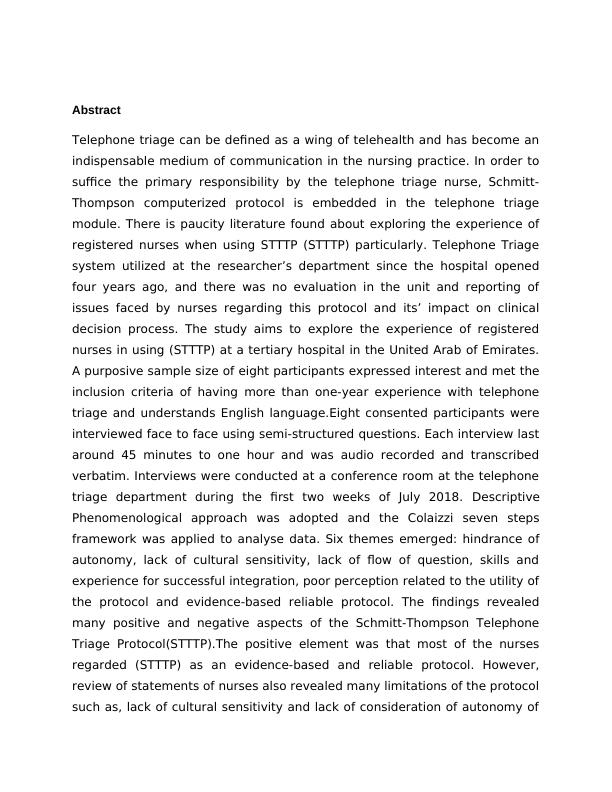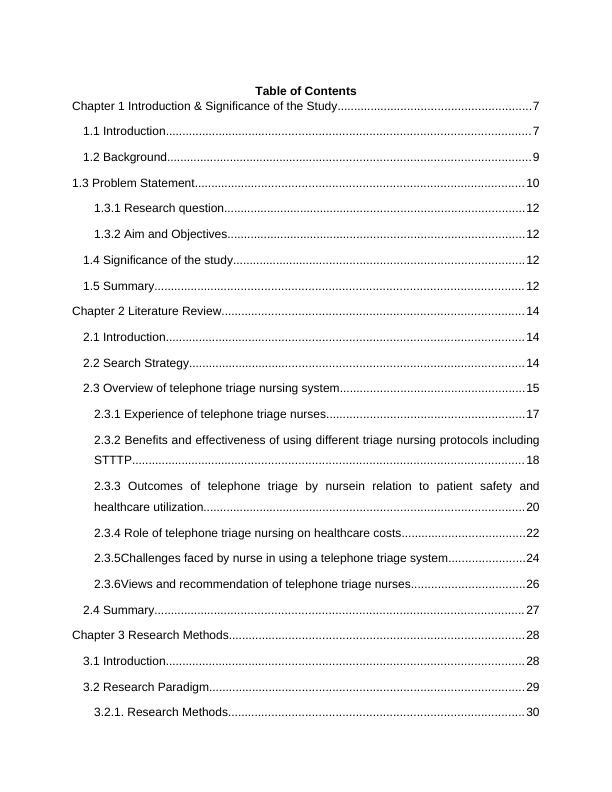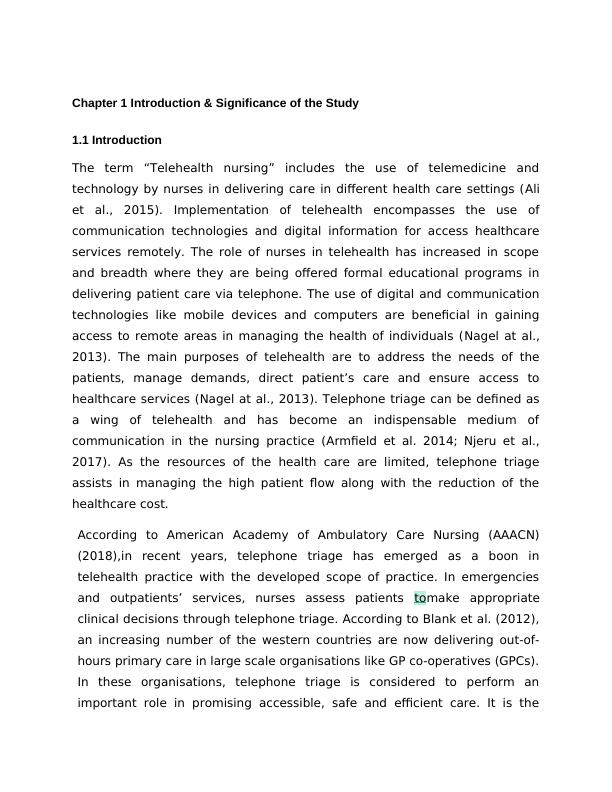Exploring the Experience of Registered Nurses in Using Schmitt-Thompson Telephone Triage Protocol: A Qualitative Study
Added on 2023-06-11
135 Pages37854 Words269 Views
Abstract
Telephone triage can be defined as a wing of telehealth and has become an
indispensable medium of communication in the nursing practice. In order to
suffice the primary responsibility by the telephone triage nurse, Schmitt-
Thompson computerized protocol is embedded in the telephone triage
module. There is paucity literature found about exploring the experience of
registered nurses when using STTTP (STTTP) particularly. Telephone Triage
system utilized at the researcher’s department since the hospital opened
four years ago, and there was no evaluation in the unit and reporting of
issues faced by nurses regarding this protocol and its’ impact on clinical
decision process. The study aims to explore the experience of registered
nurses in using (STTTP) at a tertiary hospital in the United Arab of Emirates.
A purposive sample size of eight participants expressed interest and met the
inclusion criteria of having more than one-year experience with telephone
triage and understands English language.Eight consented participants were
interviewed face to face using semi-structured questions. Each interview last
around 45 minutes to one hour and was audio recorded and transcribed
verbatim. Interviews were conducted at a conference room at the telephone
triage department during the first two weeks of July 2018. Descriptive
Phenomenological approach was adopted and the Colaizzi seven steps
framework was applied to analyse data. Six themes emerged: hindrance of
autonomy, lack of cultural sensitivity, lack of flow of question, skills and
experience for successful integration, poor perception related to the utility of
the protocol and evidence-based reliable protocol. The findings revealed
many positive and negative aspects of the Schmitt-Thompson Telephone
Triage Protocol(STTTP).The positive element was that most of the nurses
regarded (STTTP) as an evidence-based and reliable protocol. However,
review of statements of nurses also revealed many limitations of the protocol
such as, lack of cultural sensitivity and lack of consideration of autonomy of
Telephone triage can be defined as a wing of telehealth and has become an
indispensable medium of communication in the nursing practice. In order to
suffice the primary responsibility by the telephone triage nurse, Schmitt-
Thompson computerized protocol is embedded in the telephone triage
module. There is paucity literature found about exploring the experience of
registered nurses when using STTTP (STTTP) particularly. Telephone Triage
system utilized at the researcher’s department since the hospital opened
four years ago, and there was no evaluation in the unit and reporting of
issues faced by nurses regarding this protocol and its’ impact on clinical
decision process. The study aims to explore the experience of registered
nurses in using (STTTP) at a tertiary hospital in the United Arab of Emirates.
A purposive sample size of eight participants expressed interest and met the
inclusion criteria of having more than one-year experience with telephone
triage and understands English language.Eight consented participants were
interviewed face to face using semi-structured questions. Each interview last
around 45 minutes to one hour and was audio recorded and transcribed
verbatim. Interviews were conducted at a conference room at the telephone
triage department during the first two weeks of July 2018. Descriptive
Phenomenological approach was adopted and the Colaizzi seven steps
framework was applied to analyse data. Six themes emerged: hindrance of
autonomy, lack of cultural sensitivity, lack of flow of question, skills and
experience for successful integration, poor perception related to the utility of
the protocol and evidence-based reliable protocol. The findings revealed
many positive and negative aspects of the Schmitt-Thompson Telephone
Triage Protocol(STTTP).The positive element was that most of the nurses
regarded (STTTP) as an evidence-based and reliable protocol. However,
review of statements of nurses also revealed many limitations of the protocol
such as, lack of cultural sensitivity and lack of consideration of autonomy of

both the nurses and the patients, affecting nurse-patient’s relationships. As
well as, poor perception of the tool because of poor application of clinical
expertise was also found. This study recommended training and skill
development as important part of the process and the findings gives the
implication to adapt innovative measures to effectively implement Schmitt-
Thompson protocol in clinical setting.
well as, poor perception of the tool because of poor application of clinical
expertise was also found. This study recommended training and skill
development as important part of the process and the findings gives the
implication to adapt innovative measures to effectively implement Schmitt-
Thompson protocol in clinical setting.

Table of Contents
Chapter 1 Introduction & Significance of the Study..........................................................7
1.1 Introduction.............................................................................................................7
1.2 Background.............................................................................................................9
1.3 Problem Statement.................................................................................................. 10
1.3.1 Research question..........................................................................................12
1.3.2 Aim and Objectives.........................................................................................12
1.4 Significance of the study.......................................................................................12
1.5 Summary.............................................................................................................. 12
Chapter 2 Literature Review.......................................................................................... 14
2.1 Introduction........................................................................................................... 14
2.2 Search Strategy....................................................................................................14
2.3 Overview of telephone triage nursing system.......................................................15
2.3.1 Experience of telephone triage nurses...........................................................17
2.3.2 Benefits and effectiveness of using different triage nursing protocols including
STTTP..................................................................................................................... 18
2.3.3 Outcomes of telephone triage by nursein relation to patient safety and
healthcare utilization................................................................................................20
2.3.4 Role of telephone triage nursing on healthcare costs.....................................22
2.3.5Challenges faced by nurse in using a telephone triage system.......................24
2.3.6Views and recommendation of telephone triage nurses..................................26
2.4 Summary.............................................................................................................. 27
Chapter 3 Research Methods........................................................................................28
3.1 Introduction........................................................................................................... 28
3.2 Research Paradigm..............................................................................................29
3.2.1. Research Methods........................................................................................ 30
Chapter 1 Introduction & Significance of the Study..........................................................7
1.1 Introduction.............................................................................................................7
1.2 Background.............................................................................................................9
1.3 Problem Statement.................................................................................................. 10
1.3.1 Research question..........................................................................................12
1.3.2 Aim and Objectives.........................................................................................12
1.4 Significance of the study.......................................................................................12
1.5 Summary.............................................................................................................. 12
Chapter 2 Literature Review.......................................................................................... 14
2.1 Introduction........................................................................................................... 14
2.2 Search Strategy....................................................................................................14
2.3 Overview of telephone triage nursing system.......................................................15
2.3.1 Experience of telephone triage nurses...........................................................17
2.3.2 Benefits and effectiveness of using different triage nursing protocols including
STTTP..................................................................................................................... 18
2.3.3 Outcomes of telephone triage by nursein relation to patient safety and
healthcare utilization................................................................................................20
2.3.4 Role of telephone triage nursing on healthcare costs.....................................22
2.3.5Challenges faced by nurse in using a telephone triage system.......................24
2.3.6Views and recommendation of telephone triage nurses..................................26
2.4 Summary.............................................................................................................. 27
Chapter 3 Research Methods........................................................................................28
3.1 Introduction........................................................................................................... 28
3.2 Research Paradigm..............................................................................................29
3.2.1. Research Methods........................................................................................ 30

3.2.2. Philosophical underpinnings of phenomenology study design......................31
3.3 Study Population...................................................................................................33
3.4 Sample size and method of sample selection.......................................................33
3.4.1. Eligibility Criteria............................................................................................35
3.4.2. Access to participants....................................................................................35
3.5 Study setting.........................................................................................................36
3.6 Data Collection Method.........................................................................................37
3.6.1 Pilot interview................................................................................................. 38
3.6.2. Data collection procedure..............................................................................39
3.7 Data Analysis........................................................................................................40
3.8 Trustworthiness and Rigour..................................................................................42
3.9 Ethical Considerations..........................................................................................42
3.10 Summary............................................................................................................ 44
Chapter 4 Findings.........................................................................................................46
4.1 Introduction........................................................................................................... 46
4.2 Participant’s Characteristics..................................................................................46
4.3 Data Analysis process......................................................................................47
4.3.1 Step 1: Transcribing of interviews...................................................................48
4.3.2 Step 2: Extraction of significant statements:...................................................48
4.3.3 Step 3: Formulating meanings from significant statements............................50
4.3.4 Step 4: Creation of themes.............................................................................52
4.3.5: Exhaustive description of themes..................................................................62
4.3.6: Participant validation..................................................................................... 63
4.4 Summary.............................................................................................................. 64
Chapter 5: Discussion....................................................................................................65
3.3 Study Population...................................................................................................33
3.4 Sample size and method of sample selection.......................................................33
3.4.1. Eligibility Criteria............................................................................................35
3.4.2. Access to participants....................................................................................35
3.5 Study setting.........................................................................................................36
3.6 Data Collection Method.........................................................................................37
3.6.1 Pilot interview................................................................................................. 38
3.6.2. Data collection procedure..............................................................................39
3.7 Data Analysis........................................................................................................40
3.8 Trustworthiness and Rigour..................................................................................42
3.9 Ethical Considerations..........................................................................................42
3.10 Summary............................................................................................................ 44
Chapter 4 Findings.........................................................................................................46
4.1 Introduction........................................................................................................... 46
4.2 Participant’s Characteristics..................................................................................46
4.3 Data Analysis process......................................................................................47
4.3.1 Step 1: Transcribing of interviews...................................................................48
4.3.2 Step 2: Extraction of significant statements:...................................................48
4.3.3 Step 3: Formulating meanings from significant statements............................50
4.3.4 Step 4: Creation of themes.............................................................................52
4.3.5: Exhaustive description of themes..................................................................62
4.3.6: Participant validation..................................................................................... 63
4.4 Summary.............................................................................................................. 64
Chapter 5: Discussion....................................................................................................65

5.1 Introduction........................................................................................................... 65
5.2 Interpretation of demographic data.......................................................................65
5.3 Discussion the result per theme............................................................................66
5.3.1 Analysis of emerge theme 1: Clinical decision making process.....................66
5.3.2 Analysis of theme 2: Lack of appropriate structure of questions....................68
5.3.3 Analysis of theme 3: Patients not taking nurse’s telephone care advice &
disagree with the dispositions..................................................................................70
5.3.4 Analysis of theme 4: Lack of cultural sensitivity..............................................71
5.3.5 Analysis of theme 5: Evidence-based and reliable protocol...........................72
5.3.6 Analysis of theme 6: Skill and training needed for successful integration of the
Schmitt protocol.......................................................................................................74
5.3.7 Summative overview of the themes................................................................76
5.4 Summary:............................................................................................................. 76
Chapter 6: Conclusion....................................................................................................78
6.1 Introduction........................................................................................................... 78
6.2 Strength and limitations........................................................................................ 79
6.3 Implication to nursing practice..............................................................................79
6.4 Implication to management...................................................................................79
6.5 Implication to education........................................................................................80
6.6 Dissemination of findings......................................................................................80
6.7 Recommendations................................................................................................82
6.9 Conclusion............................................................................................................83
6.10 Reflection............................................................................................................83
References.....................................................................................................................87
Appendices.................................................................................................................... 98
5.2 Interpretation of demographic data.......................................................................65
5.3 Discussion the result per theme............................................................................66
5.3.1 Analysis of emerge theme 1: Clinical decision making process.....................66
5.3.2 Analysis of theme 2: Lack of appropriate structure of questions....................68
5.3.3 Analysis of theme 3: Patients not taking nurse’s telephone care advice &
disagree with the dispositions..................................................................................70
5.3.4 Analysis of theme 4: Lack of cultural sensitivity..............................................71
5.3.5 Analysis of theme 5: Evidence-based and reliable protocol...........................72
5.3.6 Analysis of theme 6: Skill and training needed for successful integration of the
Schmitt protocol.......................................................................................................74
5.3.7 Summative overview of the themes................................................................76
5.4 Summary:............................................................................................................. 76
Chapter 6: Conclusion....................................................................................................78
6.1 Introduction........................................................................................................... 78
6.2 Strength and limitations........................................................................................ 79
6.3 Implication to nursing practice..............................................................................79
6.4 Implication to management...................................................................................79
6.5 Implication to education........................................................................................80
6.6 Dissemination of findings......................................................................................80
6.7 Recommendations................................................................................................82
6.9 Conclusion............................................................................................................83
6.10 Reflection............................................................................................................83
References.....................................................................................................................87
Appendices.................................................................................................................... 98


Acknowledgements:
Dedication:
Dedication:

Chapter 1 Introduction & Significance of the Study
1.1 Introduction
The term “Telehealth nursing” includes the use of telemedicine and
technology by nurses in delivering care in different health care settings (Ali
et al., 2015). Implementation of telehealth encompasses the use of
communication technologies and digital information for access healthcare
services remotely. The role of nurses in telehealth has increased in scope
and breadth where they are being offered formal educational programs in
delivering patient care via telephone. The use of digital and communication
technologies like mobile devices and computers are beneficial in gaining
access to remote areas in managing the health of individuals (Nagel at al.,
2013). The main purposes of telehealth are to address the needs of the
patients, manage demands, direct patient’s care and ensure access to
healthcare services (Nagel at al., 2013). Telephone triage can be defined as
a wing of telehealth and has become an indispensable medium of
communication in the nursing practice (Armfield et al. 2014; Njeru et al.,
2017). As the resources of the health care are limited, telephone triage
assists in managing the high patient flow along with the reduction of the
healthcare cost.
According to American Academy of Ambulatory Care Nursing (AAACN)
(2018),in recent years, telephone triage has emerged as a boon in
telehealth practice with the developed scope of practice. In emergencies
and outpatients’ services, nurses assess patients tomake appropriate
clinical decisions through telephone triage. According to Blank et al. (2012),
an increasing number of the western countries are now delivering out-of-
hours primary care in large scale organisations like GP co-operatives (GPCs).
In these organisations, telephone triage is considered to perform an
important role in promising accessible, safe and efficient care. It is the
1.1 Introduction
The term “Telehealth nursing” includes the use of telemedicine and
technology by nurses in delivering care in different health care settings (Ali
et al., 2015). Implementation of telehealth encompasses the use of
communication technologies and digital information for access healthcare
services remotely. The role of nurses in telehealth has increased in scope
and breadth where they are being offered formal educational programs in
delivering patient care via telephone. The use of digital and communication
technologies like mobile devices and computers are beneficial in gaining
access to remote areas in managing the health of individuals (Nagel at al.,
2013). The main purposes of telehealth are to address the needs of the
patients, manage demands, direct patient’s care and ensure access to
healthcare services (Nagel at al., 2013). Telephone triage can be defined as
a wing of telehealth and has become an indispensable medium of
communication in the nursing practice (Armfield et al. 2014; Njeru et al.,
2017). As the resources of the health care are limited, telephone triage
assists in managing the high patient flow along with the reduction of the
healthcare cost.
According to American Academy of Ambulatory Care Nursing (AAACN)
(2018),in recent years, telephone triage has emerged as a boon in
telehealth practice with the developed scope of practice. In emergencies
and outpatients’ services, nurses assess patients tomake appropriate
clinical decisions through telephone triage. According to Blank et al. (2012),
an increasing number of the western countries are now delivering out-of-
hours primary care in large scale organisations like GP co-operatives (GPCs).
In these organisations, telephone triage is considered to perform an
important role in promising accessible, safe and efficient care. It is the

End of preview
Want to access all the pages? Upload your documents or become a member.
Related Documents
001293G - Report on Nursing Intervention By PICOlg...
|20
|4971
|238
Nursing Shortage and Patient Outcomes: A Literature Reviewlg...
|6
|1897
|260
(PDF) The types and causes of medication errors in nursinglg...
|50
|11630
|78
The Knowledge of Disaster Preparedness Management by Nurses in Emergency Department in Saudi Arabialg...
|40
|12059
|452
Factors Affecting Staff Attitude towards Elderly Patients in Healthcare: A Critical Studylg...
|31
|6035
|99
Perception of Physicians about Advanced Nurse Practitioners in Saudi Arabialg...
|59
|11894
|444
